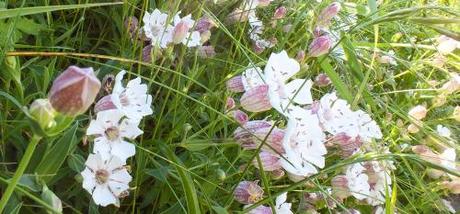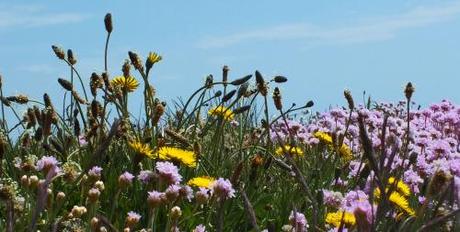
The weather has been so beautiful recently, and at long last the wildflowers are in full bloom along the Cornish coast, giving us a spectacular display. On Sunday, I decided to head off for Coverack on the east coast of The Lizard, and made my way from there along the South West Coast Path up to Lowland Point.
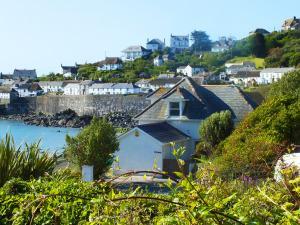
Coverack from the east (photo: Amanda Scott)
Coverack itself is of course a lovely coastal village and working harbour, with a very active community – see their website here for lots of information and details of events. However, this time I didn’t linger there, although after parking the car, fairly early with just me and two or three dog walkers about, I did spend a moment or two simply enjoying the salty, seaweedy smell and the sounds of the sea.
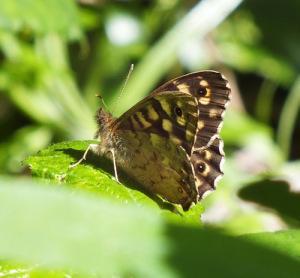
Speckled Wood butterfly – posing nicely for me on the path out of Coverack (photo: Amanda Scott)
As you set off east out of the village, first of all along a narrow lane through houses and then a gravel track, the path is gently wooded. There is a bench fairly early on, generously provided by a nearby house owner: I didn’t need to rest, but walkers who have put more miles in must love to sit and relish the sea view ! It was good to see butterflies flitting about, warming their wings in the early sunlight: I spotted this Speckled Wood, and also saw a Wall butterfly and a few Common Blues and Green-veined Whites.
The South West Coast Path then turns right down a descending rocky path. This had very much an ‘edge of the wood’ feel to it: Beech and Ivy arch overhead creating a woven ceiling to the path, a Woodpigeon gazed at me before diving into the trees, a stream chattered away to the right…but glimpses of the sea and the constant rush of waves beneath the woodland birdsong were a reminder that the coast was very near.
And then the wood ends and the view opens out.
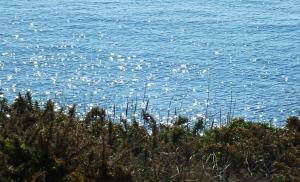
Sparkling sea (photo: Amanda Scott)

The cliff drops down to the beach near to Lowland Point, and Thrift and other clifftop flowers grow at the beach edge (photo: Amanda Scott)
The way to Lowland Point is about 1.5 miles long from Coverack: it is straight and clear, beginning along higher cliffs but ending much lower, first passing alongside low sandy crumbly cliffs (a raised beach in geological terms) and finally dropping down to the same level as the pebbly beach, before rising slightly again at Lowland Point – it is easy to see how this headland gets its name. The landscape round here, as well as being lovely in the ‘here and now’, is also full of history, with archaeological sites from the prehistoric era, the remains of medieval field systems, and some Romano-British saltworks (Trebarveth) right at the edge of the cliffs. I failed to find the latter – very frustratingly as I must have walked right past it – and I’ll have to go back for another look!
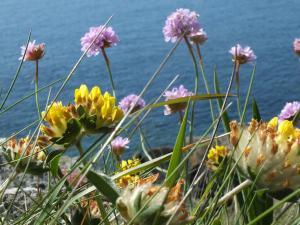
Thrift and Kidney Vetch (photo: Amanda Scott)
But the real stars of the day were the flowers. Milkwort, Thrift, Kidney Vetch, Foxgloves finally out, together with Sea Campion, Red Campion, Yellow Irises just starting to bloom alongside Cuckooflower and Ragged Robin in the boggier patches, Bluebells, Tormentil…I could go on and on and on…Instead, I’ve added a species list of what I found at the end of this post (which is probably only a small proportion of what was there…).
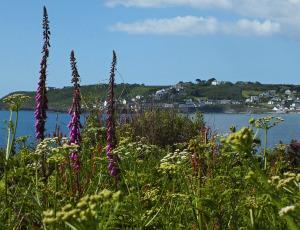
Coverack from the wildflower meadow on the coastal path (photo: Amanda Scott)
One of my favorite places was a beautiful wildflower meadow, to the left of the path approximately midway between Coverack and Lowland Point. I carefully walked through it: many of the plants were up to waist height and more. This was the first place and time this year I had seen Foxgloves properly out, looking fresh and pink.
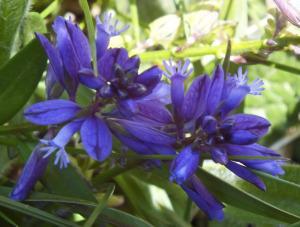
Common Milkwort: this small delicate flower was abundant in both the woods and on the cliffs (photo: Amanda Scott)

English Stonecrop was just beginning to flower on rocks at the cliff edge (photo: Amanda Scott)
A lovely walk, beautiful scenery, sea, cliffs, geology, archaeology, rich flora, insects and other fauna – what a wonderful way to spend a Sunday morning! Mine was a ‘there and back again’ walk as I was loathe to leave the cliff top flowers and sea view, but there are circular walks in the area – see this one for example.
PLANT SPECIES LIST:
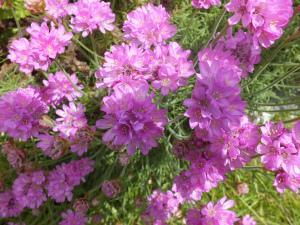
Thrift (photo: Amanda Scott)
Beech
Bluebell
Bracken
Bugle
Cock’s-foot
Common Dog Violet
Common Milkwort
Common Sorrel
Creeping Buttercup
Cuckooflower
English Stonecrop
European Gorse
Foxglove
Greater Plantain
Greater Stitchwort
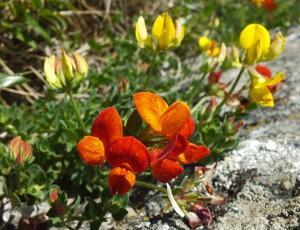
Kidney Vetch (photo: Amanda Scott)Greater Stitchwort
Hazel
Herb Robert
Honeysuckle
Ivy
Kidney Vetch
Lesser Spearwort
Lesser Stitchwort
Meadow Buttercup
Navelwort
Pignut
Ragged Robin
Red Campion
Ribwort Plantain
Round-leaved Crowfoot
Sea Campion
Sweet Vernal Grass
Three-cornered Leek
Thrift
Tormentil
Wild Clematis
Yellow Iris
